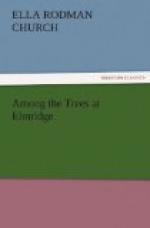“If they would only keep still!” exclaimed Edith, who felt a strong sympathy for the green pigeons. “Poor pretty things! Why don’t they, Miss Harson, instead of getting killed?”
“They do not know their danger until it is too late, and it is quite as hard for them to keep still as it is for little girls.”
Edith wondered if that meant her; she was a little girl, but she did not think she was so very restless. However, Miss Harson didn’t tell her, and she soon forgot it in listening to what was said of the queer tree with branches like snakes.
“The leaves of the banyan tree are large and soft and of a very bright green, and the deep shade and pillared walks are so welcome to the Hindu that he even tries to improve on Nature and coax the shoots to grow just where he wishes them. He binds wet clay and moss on the branch to make the rootlet sprout.”
“Will it grow then?” asked Malcolm.
“Yes, just as a cutting planted in the earth will grow, although it seems a very odd style of gardening.—The sacred fig tree of India—Ficus religiosa—is a near relative of the banyan, and very much like it in general appearance; but the leaves are on such slender stalks that they tremble like those of the aspen. It is known as the bo tree of Ceylon, and is said to have been placed in charge of the priests long before the present race of inhabitants had appeared in the island.”
“Where do the real figs grow?” asked Clara.
“In a great many moderately warm or sub-tropical countries,” was the reply, “but Smyrna figs are the most celebrated. Immense quantities of the fruit are dried and packed in Asiatic Turkey for exportation from this city, and it is said that in the fig season nothing else is talked about there.”
“I didn’t know that they were dried,” said Malcolm, in great surprise; “I thought they were just packed tight in boxes and then sent off.”
[Illustration: LEAF AND FRUIT OF THE FIG TREE.]
“‘In its native country,’” read Miss Harson, “’and when growing on the tree, the fig presents a different appearance from the dried and packed specimens we see in this country. It is a firm and fleshy fruit, and has a delicious honey-drop hanging from the point.’ And here,” she added, “is a small branch from the fig tree, with fruit growing on it.”
“Why, it’s shaped like a pear!” exclaimed Malcolm.
“And what large, pretty leaves it has!” said Clara.
“‘The fig tree is common in Palestine and the East,’” Miss Harson continued to read, “’and flourishes with the greatest luxuriance in those barren and stony situations, where little else will grow. Its large size and its abundance of five-lobed leaves render it a pleasant shade-tree, and its fruit furnishes a wholesome food very much used in all the lands of the Bible.’ Figs were among the fruits mentioned in the ‘land that flowed with milk and honey,’ and it was a symbol of peace and plenty, as you will find, Malcolm, by reading to us from First Kings, fourth chapter, twenty-fifth verse.”




